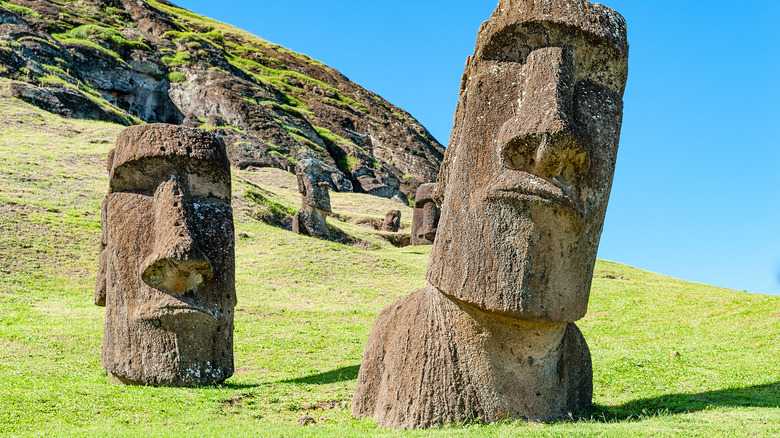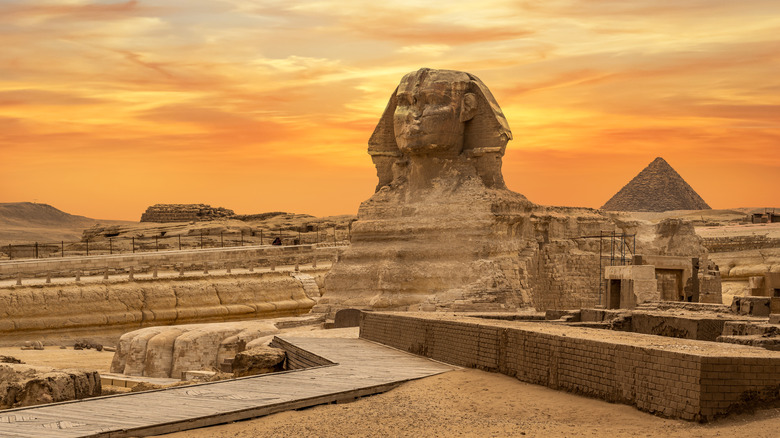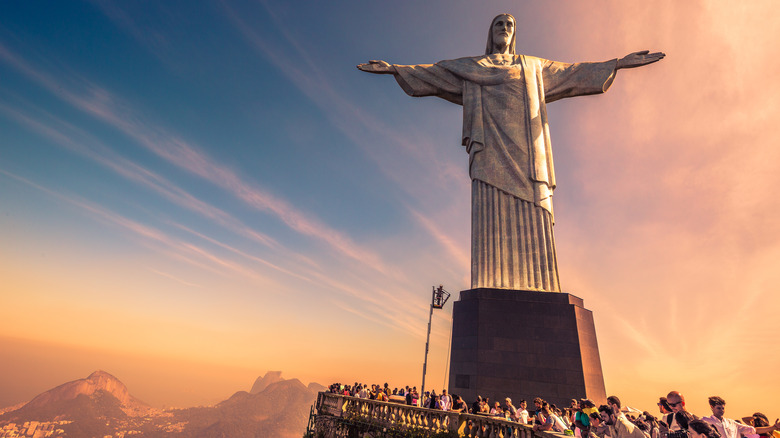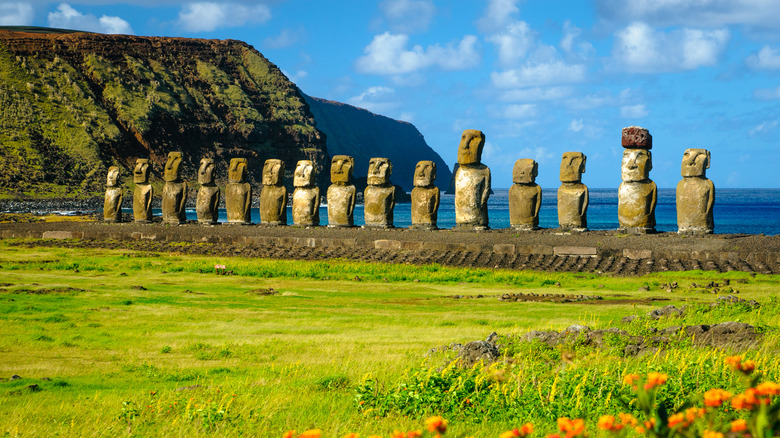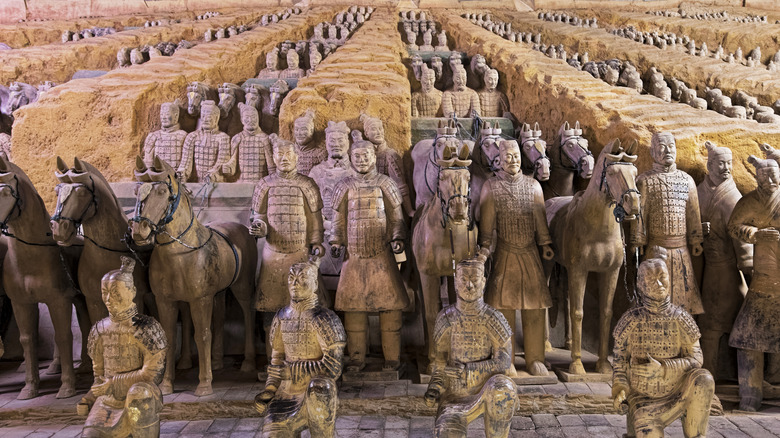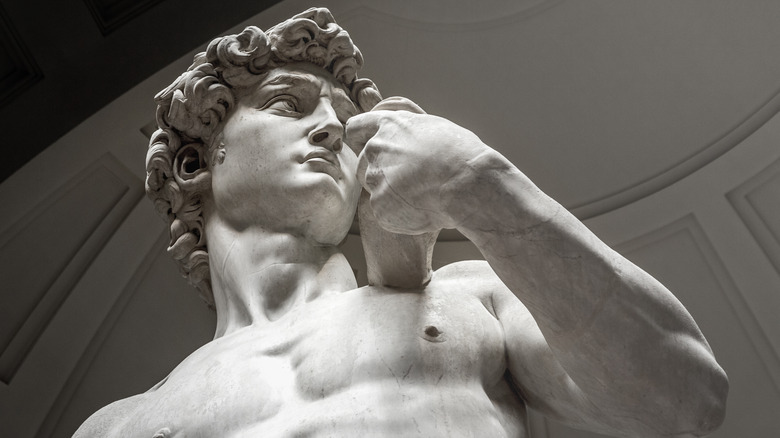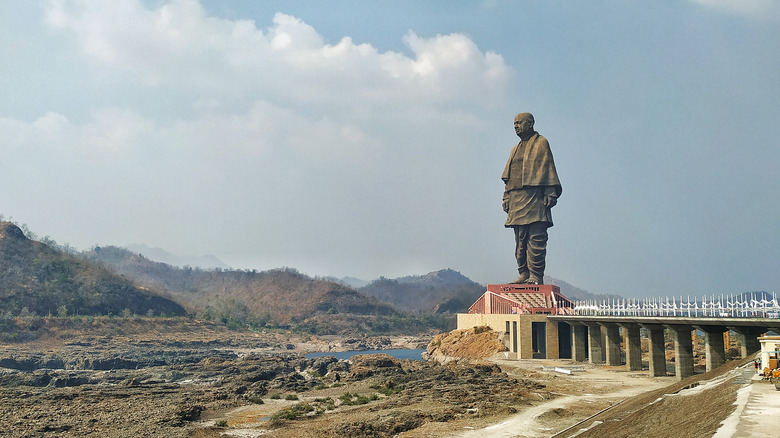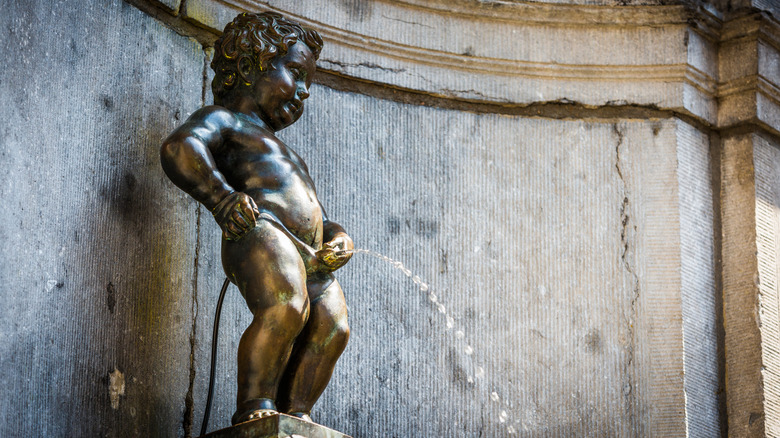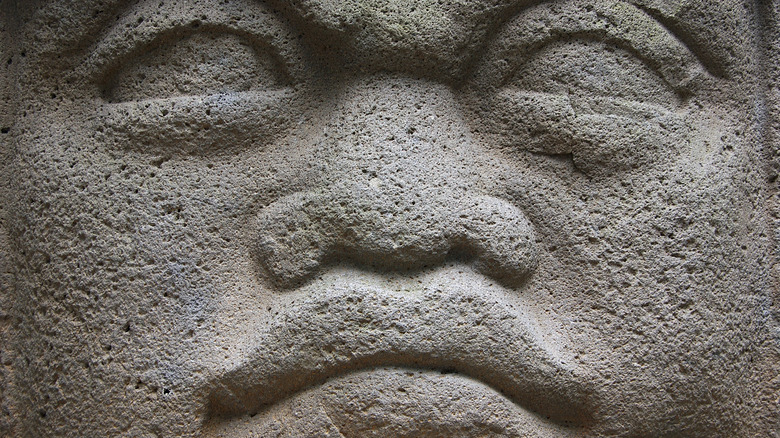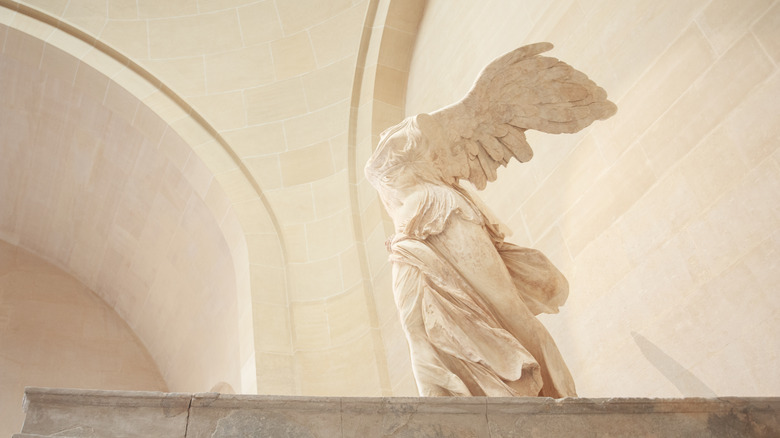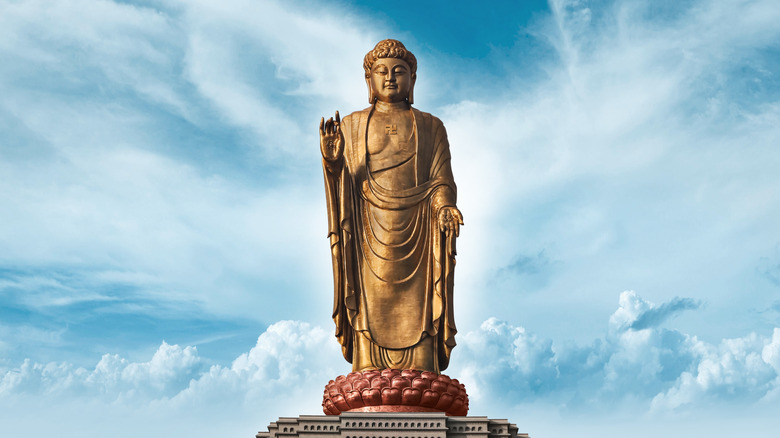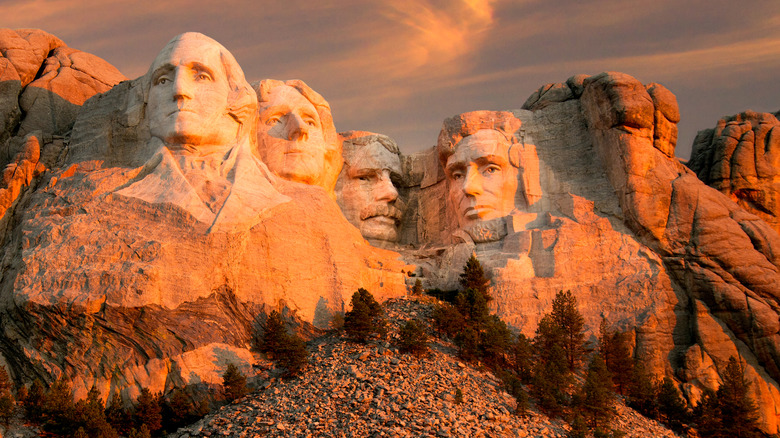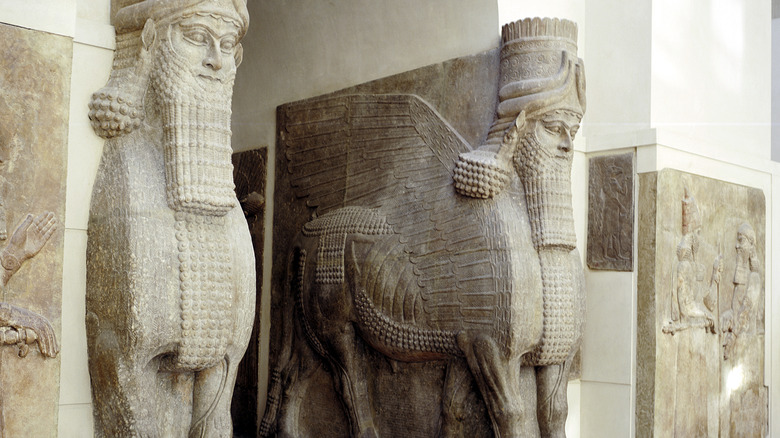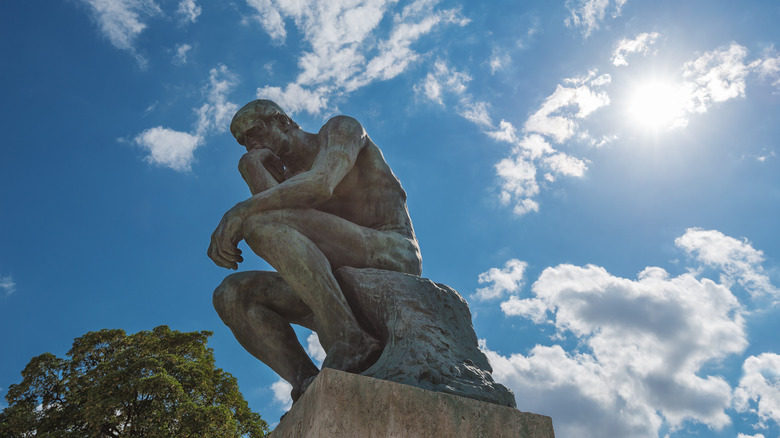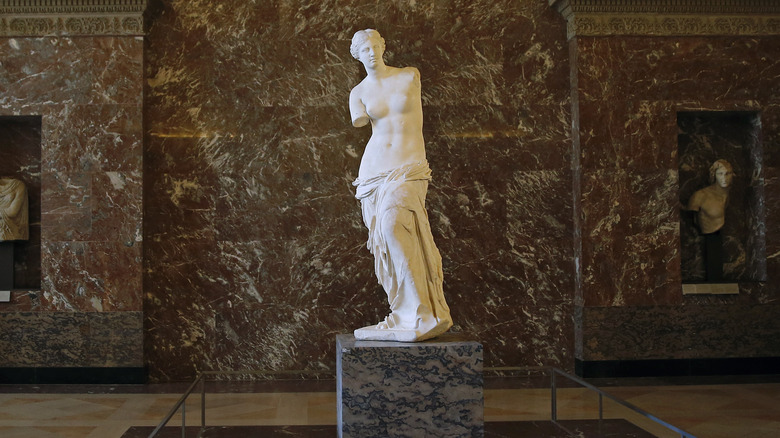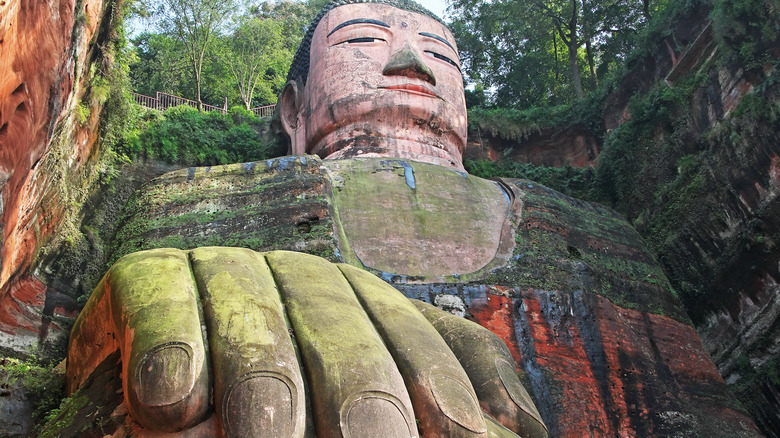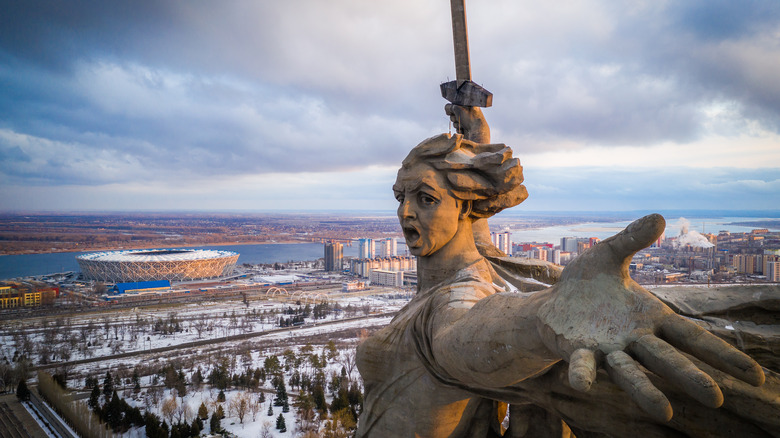The Most Famous Statues In The World
Since time immemorial, human beings have left behind immortal works of art. From the cave paintings of Lascaux, France to Leonardo da Vinci's iconic "Mona Lisa," the creative spirit has sought permanence through artwork for millennia. Besides images hashed out in paint, statues remain another prevalent form of representational imagery. Some of history's sculptures have proven so renowned that their fame continues today. And this, despite the original pieces no longer existing.
They include the "Colossus of Rhodes," a massive statue of Helios, the sun god. Crafted from bronze reinforced with iron, it stood 105 feet tall and was one of the Seven Ancient Wonders of the World, per Britannica. We also know that Greece's Parthenon once housed a gigantic statue of the gold-covered goddess Athena (via World History). And Olympia, Greece, boasted a monumental gilt ivory representation of Zeus.
It's mind-boggling to contemplate the fame of statues that no longer exist, inspiring a fascinating question: Which monuments of today will stand the test of time? While we don't have a crystal ball, we do have a handle on the most famous statues in the world. Here's our list of these extraordinary figures.
Egypt's Great Sphinx of Giza
The Great Sphinx of Giza is all about superlatives. According to Britannica, it's one of the largest sculptures in the world. And it's also one of the oldest and most famous. The massive work is located on the Giza plateau and comprises a single limestone ridge. All told, the amalgamation of a royal headdress-wearing man with a lion's body measures 240 feet long by 66 feet tall.
Most scholars say it dates to around 2500 B.C., as reported by CBS News. But a new theory suggests it could be upwards of 9,000 years old based on "precipitation-induced weathering" on the statue's upper portions. They argue that the rainfall necessary for this deterioration last occurred in the area around 7,000 B.C. This much older dating scheme would make the Sphinx the work of a sophisticated civilization that pre-dated the Egyptians. (Hello, Atlanteans!) For this reason, it remains a controversial theory, albeit a fascinating one. And, of course, ancient alien theorists also have something to say about the statue's origins. But that's a story for another time, per History.
Regardless of its ultimate age, the monument remained neck-deep in Egyptian sands for thousands of years, per Smithsonian Magazine. Although Captain Giovanni Battista Caviglia first led an expedition to dig it out in 1817, he proved unsuccessful at countering the unending onslaught of sand. In 1930, Selim Hassan finally set the statue free, but the mysteries surrounding its construction and meaning remain tantalizing.
Brazil's 'Christ the Redeemer' statue
Nothing says Brazil like the "Christ the Redeemer" statue in Rio de Janeiro, per Britannica. Completed in 1931, it towers above the city with arms spread open in a cross shape. The figure measures 98 feet tall with an arm span of 92 feet. Construction began in 1922 atop Mount Corcovado in Tijuca National Park, the "world's largest urban forest," according to Simona Stoppa's "Brazil." Today, the reinforced concrete statue represents the largest Art Deco sculpture on Earth. A closer inspection reveals the exterior surface, comprised of thousands of triangular soapstone tiles arranged in a mosaic pattern (via Google Arts & Culture).
The first ceremonial stone for the statue project was laid in 1922, corresponding to the centennial of Brazil's break away from its former colonizer, Portugal. But the idea of a monumental Jesus statue pre-dated the stone laying by many decades. Priest Pedro Maria Boss first suggested the monument in the 1850s. He intended the statue to commemorate Emperor Pedro II's daughter, Isabel, the regent of Brazil. But this project never came to fruition.
Eventually, Rio de Janeiro's Roman Catholic archdiocese suggested another Jesus building project in 1921. Citizens submitted a petition to Brazil's president, Epitácio Pessoa, in support of the project. After receiving approval, Heitor da Silva Costa, a Brazilian engineer, headed up the project. He collaborated with Carlos Oswald, a Brazilian artist, and Paul Landowski, a French sculptor, to breathe life into the impressive monument.
America's Statue of Liberty
Among the most celebrated monuments worldwide is New York's "The Statue of Liberty Enlightening the World," gifted to the United States by the French and officially put on display in 1886, according to the National Park Service (NPS). Seen as a symbol of democracy and liberty today, it's also hard to miss.
According to the NPS, the statue weighs 225 tons (450,000 pounds) and measures 305 feet tall. According to the New York Times, Lady Liberty holds a solid copper torch covered in 24-carat gold leaf. This bling-y accessory replaced the original in 1984, and it was crafted by Les Metalliers Champenois of Reims to faithfully reproduce the original design by Frédéric August Bartholdi. The French metalworkers even treated the hammered copper to give it an antique green patina like the rest of the statue.
At this point, you may wonder what inspired Bartholdi to craft a female representation of freedom? The image comes from the ancient Roman goddess Libertas, a "personification of liberty and personal freedom" (via Britannica). She, in turn, shares associations with the Colossus of Rhodes, the well-remembered though now-defunct Wonder of the Ancient World, according to the Greek Reporter. Besides the statue's ancient origins, artist Hidreley Leli Dião recently used technology to recreate the sculpture as a real-life woman, per Newsweek. And she's surprisingly ordinary-looking despite all the goddess and wonder hype.
Easter Island's moais
Easter Island measures just 7 miles wide and 14 miles long, as reported by Smithsonian Magazine. Considered the "most remote inhabited place on earth," it sits 2,500 miles away from Tahiti and 2,300 miles from Chile's west coast, according to History. Despite its isolation, the island has long been renowned for mysterious statues, known as moai. Some stand 30 feet tall and weigh upwards of 80 tons. All told, the island contains almost 1,000 of them.
When Captain James Cook encountered the island and its inhabitants in 1774, the moai blew his mind. He observed, "We could hardly conceive how these islanders, wholly unacquainted with any mechanical power, could raise such stupendous figures" (via Smithsonian Magazine). Without a clear understanding of the moai's origins, Cook hypothesized about potential construction methods. He guessed that the building process involved scaffolding and piles of stones.
Since their original discovery, researchers have remained fascinated by the moai, who created them, and their ultimate meaning. They've also explored questions regarding the significance of the statues. Today's archaeologists believe the original inhabitants of Easter Island came from another Polynesian island. But no consensus exists about which one. The same goes for arrival dates, ranging from the first to the sixth century A.D. As for the statue creation process, they were carved from a type of volcanic ash that proved soft and easy to work. Then, archaeologists believe they got moved into position using ropes, sleds, and log rollers.
China's Terracotta Army
During the reign of China's first emperor, Qin Shi Huangdi, from 259 to 210 B.C., artisans at his court crafted an underground realm populated by a life-size army of terra cotta soldiers and horses, per Live Science. Since the initial discovery of this standing army near the unexcavated tomb of the emperor, the terracotta statues have gained international fame. Some have even toured with traveling exhibitions, according to Smithsonian Magazine.
Researchers today believe the site contains 8,000 sculpted warriors, although new pits of soldiers are still turning up. Live Science reported the announcement of archaeologists in February 2022 of the discovery of 20 additional warriors. The new warriors include a general and infantry members, which will be restored by the Emperor Qin Shu Huang Mausoleum Site Museum.
But excavations have revealed there's more to Qin Shi Huangdi's subterranean kingdom than just a standing army. Archaeologists have uncovered terracotta musicians as well as realistic bronze statues of waterfowl. According to Duan Qingbo of the Shaanxi Provincial Research Institute for Archaeology, "We find the underground pits are an imitation of the real organization in the Qin dynasty." In other words, instead of simply interring himself with a standing army, Huangdi ended up recreating "a whole political system" (via Smithsonian Magazine).
Italy's 'The David'
According to Britannica, Michelangelo Buonarroti is among the most celebrated artists of the Italian Renaissance, and his pop culture footprint proves vast — whether we're talking the Sistine Chapel, the Pieta, or the pizza-devouring Teenage Mutant Ninja Turtle. His most famous works include the nearly 14-foot-tall statue of David in Florence, Italy, per Accademia. Today, the statue represents the height of artistic perfection. Yet, Michelangelo used a marble block rejected by another artist, Agostino di Duccio, in its creation (via Britannica).
First unveiled to the public in 1504, this monumental work held special significance for the people of the Renaissance Republic of Florence, according to India Gray's "Is Michelangelo's David a Political Work of Art?" Like the biblical shepherd boy who bested Goliath on the battlefield, Florence felt like an underdog among its neighbors. As Gray argues, "Florence took pride in classical renaissance values of humanism, holding great esteem for intellectualism and rationality, to defeat a brutish and overpowering enemy." In other words, the city-state also had giants to slay.
Other artists, like Andrea del Verrochio and Donatello di Nicollò di Betto Bardi, depicted David after the battle, with the Goliath's gargantuan head severed at the teen's feet. But Michelangelo avoided these overt identifiers, portraying the future Hebrew king in the tense moments before the face-off. Gray contends removing these references to the Biblical story encouraged the audience to freely associate the statue with Florence's political predicament.
India's 'Statue of Unity'
India boasts the tallest statue globally, the "Statue of Unity," measuring twice the height of the Statue of Liberty, as reported by the New York Times. The bronze figure measures a whopping 597 feet tall and fittingly commemorates a true giant of Indian politics, Sardar Vallabhai Patel (via Statue of Unity). Although not well known outside of India, Patel helped achieve the impossible by extricating his nation from the vice-like grip of Great Britain.
But his influence went far beyond opposing the British. He also gained renown as the architect of modern India, actively working to unite the nation's 562 states into one Republic of India. No easy undertaking, Patel relied on the concept of "Vasudhaiv Kulumbakam" to draw together otherwise disparate regions. The term describes the fundamental principle that the universe represents a giant extended family. Yet, Patel proved firm when needed, gaining the nickname "Iron Man" for his ability to blend peaceful diplomacy with an uncompromising vision.
His statue towers above an expansive valley containing the river Narmada and the Sardar Sarovar Dam. The area opens onto unobstructed views in all directions. The location artfully emphasizes the monument's impressive stature. The location also permits optimal 360-degree viewing, drawing all eyes to the veritable engineering wonder. Recent regional improvements in education, transportation, tourism, and tribal development have also made the statue's location an attractive destination.
Belgium's 'Manneken Pis'
Not all statues are large and in charge. Take, for example, the diminutive "Manneken Pis," a bronze statue of a little boy peeing. It sits tucked away in a corner of Brussels, Belgium's old town (via Atlas Obscura). Despite the humble size and subject, "Manneken Pis" (meaning "little man pee") has a colorful history and ranks high on the list of must-see attractions in the Low Countries, per The Brussels Times. Two strange local stories attempt (with little satisfaction) to explain the statue's origins.
The first story contains all the hallmarks of a fairy tale. According to legend, a little boy who peed on the door of a witch faced eternal punishment, frozen forever by a spell. The second story claims the little boy as an honest-to-goodness war hero. And as you may have already guessed, he saved Brussels by urinating. More specifically, he extinguished the lit end of an explosive's fuse during an impromptu potty break. All in a day's work!
Like "The David" by Michelangelo, "Manneken Pis" is enmeshed in Brussels' civic pride. According to the Brussels Times, "The fountain has come to symbolize a certain spirit of Brussels that is both steadfast, playful, and highly individual." Of course, the statue has also inspired countless knockoffs of the kitschy garden variety, available from eBay to Amazon. What's more, a copy of the little guy made a cameo with Tom Hanks in 1986's "The Money Pit" commiserating about "prostate trouble" (via YouTube).
Mexico's Olmec colossal heads
Between 1200 and 400 B.C., a mysterious civilization known as the Olmecs carved gigantic heads from basalt (via Britannica). To date, 17 of these "colossal heads" have been uncovered, as reported by World History. Although they range in size, some noggins measure upwards of 9.8 feet tall, 14.7 feet in circumference, and weigh 8 tons.
Despite their intimidating size, they demonstrate obvious evidence of skilled craftsmanship, including naturalistic details like sensuous lips, pronounced cheekbones, prominent noses, and headgear resembling helmets. Based on the careful execution of these incredible public works, many researchers have concluded them to be portraits of significant leaders. Besides expertly carved megaliths, other Olmec artifacts also point to a highly sophisticated Mesoamerican civilization. They even constructed massive earthen works, including pyramids and platforms, that archaeologists continue to pinpoint using the remote-sensing method known as lidar, according to Reuters.
The Olmecs also invented the first writing system in the Americas, per Britannica. Evidence of this system includes the Cascajal stone dating to roughly 900 B.C. and the La Mojarra stele, cataloging 465 glyphs. The stele has helped researchers crack the code of the epi-Olmec language. That said, they still have a long way to go when it comes to fully understanding the culture's texts. Nevertheless, the Olmec heads remain, without a doubt, among the most popular Mesoamerican statuary of this great civilization, per Minerva Magazine.
Greece's 'The Winged Victory of Samothrace'
Few sights prove more breathtaking than ascending the Daru staircase in Paris, France's Louvre Museum, and seeing "The Winged Victory of Samothrace" come into view. According to Ancient World Magazine, the 18-foot-tall statue's careful execution gives her a nearly airborne vibration, ethereal and stunning simultaneously. From her mighty wings to the vivid sense of movement suggested by the windblown draping of her gown, she remains one of the most famous statues in the world despite her headless and armless state.
Researchers at the Louvre believe Victory was an offering to the gods that sat at a sanctuary located in the Aegean Sea on Greece's Samothrace Island. Intricately carved from the finest marble in the Mediterranean, quarried from Paros, she dates to circa 190 B.C., coinciding with a significant victory at sea by the inhabitants of the island of Rhodes. This is evidenced by the base of the statue, sculpted into the shape of a ship's prow, per Valérie Foret, writing for the Louvre.
Archaeologists fantasize about recovering the rest of Victory. But they've had little luck reuniting the figure with noticeable missing parts like her arms and head (or less noticeable ones like her feet). Incidentally, she's also missing her right wing, but the museum fixed this by creating a cast of the left in reverse. That said, two separate digs recovered the statue's right palm, thumb, and ring finger. These pieces reside in a small case near the statue.
China's 'Spring Temple Buddha'
One of the highest statues on the planet, the "Spring Temple Buddha" measures 420 feet tall, constructed using a whopping 15,000 tons of steel and 33 tons of copper alloy (via Travel+Leisure). Standing atop a lotus platform in China's Henan province, the statue towers 700 feet when the pedestal gets factored into its height. For comparison, America's Statue of Liberty, pedestal and all, tops out at the "Spring Temple Buddha's" waistline!
The buddha statue appears to survey the nearby Shahe River, enveloped on three sides by verdant mountains. In 2002, it cost an estimated $55 million, as reported by India Times. Although people make the trek from all over the world to see the statue, it remains surprisingly light on casual tourists. The arduous journey required to reach the monument accounts for the lack of crowds.
Buddhists in the area felt compelled to build the Spring Temple Buddha in response to the destruction of the two Bamiyan Buddhas by the Taliban in Afghanistan, per India Times. Dated to the 6th and 7th centuries A.D., these antique statues were carved directly into the cliff sides of the Bamiyan Valley, according to Smart History. They once ranked among the tallest Buddha statues in the world at 120 and 175 feet.
America's Mount Rushmore
Mount Rushmore National Memorial, located in South Dakota's Black Hills, pays tribute to four American presidents: George Washington, Thomas Jefferson, Theodore Roosevelt, and Abraham Lincoln (via Britannica). The massive, carved statues of the four presidents measure roughly 60 feet tall apiece, and the mountain sits at an elevation of 5,725 feet above sea level. Officials designated the site in 1925, and an official dedication ceremony took place in 1927. The monument became a part of the U.S. National Park Service in 1933.
In 1923, historian Doane Robinson first suggested a monumental statue to U.S. figures. Unlike American sculptor Gutzon Borglum's vision, Robinson suggested the monument commemorate famous figures from the American West, including Native Americas. Robinson suggested a rock formation in Custer State Park for the tribute. But Borglum disagreed with the choice of sites due to a lack of geological stability and evidence of heavy erosion. Instead, he suggested Mount Rushmore because of its robust granite surface.
But Borglum's changes didn't stop there. He also suggested sculpting the face of four presidents, which he felt best encapsulated the first 150 years of American history. He argued that Washington symbolized the foundation while Jefferson and Roosevelt were emblematic of westward expansion and emergence as a world power. As for Lincoln, he preserved the Union during its moment of greatest peril, the Civil War. With these artistic and historical alterations made, Borglum dug into the project, removing approximately 450,000 tons of rock in the process.
The lamassu of ancient Mesopotamia
Paris, France's Louvre Museum contains countless breathtaking sights. Among the most arresting is a visit to the Khorsabad Courtyard, where visitors can see remnants of the once grandiose Palace of Sargon II, including massive winged creatures with human heads and bull bodies known as lamassu.
Sargon II reigned over modern-day Iraq, then a part of the formidable Assyrian Empire. He constructed a new capital city in the 8th century to leave his mark on the world. Sargon II's palace alone contained more than 200 courtyards and rooms. But the site fell into disrepair following his violent death in battle in 705 B.C. After his passing, the site disappeared into the sands of time until French archaeologists rediscovered it in the 19th century.
In the ancient Mesopotamian culture, lamassu acted as protective gods, but these ancient figures need protecting today, per Smart History. Exhibitions like that at the Louvre remain central to their preservation. Nothing drove this point home more thoroughly than a 2015 video of self-proclaimed members of ISIS using jackhammers, sledgehammers, and drills to destroy artifacts at Mosul, Iraq's museum, and the nearby archaeological site of Ninevah, as reported by The New York Times.
France's 'The Thinker'
According to the Musée Rodin, "The Thinker" that comes to mind today has gone through many evolutions and versions. Conceived by Auguste Rodin in 1880, the public first saw the figure as a 2-foot-tall feature atop his larger "The Gates of Hell" work. In this diminutive form, it went by the title of "The Poet."
After a successful individual exhibition in 1888, the work's growing popularity soon merited the colossal casting most people associate with the artwork today, as reported by Britannica. Cast from bronze in 1904, the larger-than-life version measures 6 feet high, a little over 3 feet wide, and roughly 5 feet in diameter, per the Musée Rodin. Visitors continue to flock to Paris, France's Rodin Museum to get a selfie with the famed statue. Lost in a "moment of concentrated introspection," the sculpture has fascinated people for over a century.
As one of the first artists to push for wide distribution of his work, Rodin authorized endless copies in various media, from bronze to marble. He also gave the Musée Rodin permission to create more editions of his works after his death. As a result, you'll find copies of "The Thinker" located in many major cities, from Philadelphia to Buenos Aires, Tokyo to Moscow. A copy of the work also perches over the grave of Rodin and his spouse who are buried in the Parisian suburb of Meudon.
Greece's 'Venus de Milo'
Greek art often focused on idealism and the "body beautiful," per The New York Times. Nothing better articulates this fascination with a harmonious human esthetic than the "Venus de Milo," fashioned by the Antiochian sculptor Alexandros circa 150 B.C. (via Britannica). According to the Louvre Museum, after her discovery on the Greek island of Melos (modern-day Milos) in 1820, the French ambassador to Greece, the Marquis de Rivière, had to have her.
After his successful acquisition, he presented the armless goddess to King Louis XVIII, and the king passed the classical beauty on to the Louvre in March 1821. After her initial arrival in France, some people suggested restoring her missing arms. But this plan was eventually scrapped due to trepidation about irreversibly altering the work. Some of the anxiety about repairing the statue stemmed from the controversy surrounding its identity. The arms of Greco-Roman gods and goddesses often contained vital clues about the figure's identity, including objects or natural elements held in the hands.
But scholars didn't have the luxury of seeing her arms or hands. Eventually, they decided on Venus (Aphrodite to the Greeks) because of her sensual semi-naked portrayal and speculation about the jewelry she once wore. What's more, researchers have determined that a hand holding an apple (found near the site of the original figure) was carved of the same Parian marble. Since the apple could symbolize the goddess of love, this helped confirm the call made in the 19th century.
China's Giant Buddha
At Mount Emei in Sichuan Province, you'll find the site of the first Buddhist temple in China and the impressive Leshan Giant Buddha, ranked as the most enormous Buddha statue on the planet, according to the UNESCO World Heritage Centre (WHC). According to the BBC, the statue's creators carved it out of a cliff face, and it remains a hugely popular tourist attraction, drawing cruise ships from the Three Gorges and Yangtze River.
According to Smithsonian Magazine, the statue dates to the 8th century A.D. and measures 233-foot-tall. The seated figure appears to survey the meeting point of three rivers, and the surrounding forest boasts trees more than a millennium old, attesting to the ancient nature of the region (via the WHC). To better understand the size of the statue requires context. Legend states that as many as 100 monks can sit on the Giant Buddha's feet at one time. And if the Giant Buddha of Leshan could stand, he would end up eye-to-eye with the Statue of Liberty.
In 2020, disastrous flooding across China brought waters to the very toes of the Buddha statue. Although local officials worked hard to sandbag the area to protect the Buddha, these attempts eventually failed. Although the figure weathered the disaster, it faces other challenges from air pollution and erosive rainwater, which will likely translate into future repairs like the $33 million spent in 2001 by the Chinese government to restore the national treasure.
Russia's 'The Motherland Calls'
Located on Mamayev Hill near Volgograd, Russia, "The Motherland Calls" commemorates the Russian soldiers and civilians who fought in World War II's Battle of Stalingrad (via Britannica). It marks the largest statue in Europe at nearly 280 feet tall, per Atlas Obscura. As Sergey Gordeev notes, "It has the scale of America's National Mall and the seriousness of Pearl Harbor" (as quoted by National Geographic).
Between August 1942 and February 1943, more than one million Russian soldiers and 40,000 civilians died defending the city. Beneath the statue's base are the graves of 35,000 unknown soldiers. The mind-boggling numbers reflect the brutal nature of warfare on the Eastern Front. (According to the National WWII Museum, Adolph Hitler ordered every woman of the city deported and all men killed). With their backs against the wall, the Russians fought ferociously and tirelessly, eventually repelling the Germans from Stalingrad and the nation.
"The Motherland Calls" was erected in 1967 to mark the 25th anniversary of the battle, states Jochen Hellbeck in "Stalingrad: The City That Defeated the Third Reich." At a location where so many members lost their lives, the statue remains a fitting tribute. It also reminds the world of Russia's often overlooked role in defeating the Nazi war machine. As the author of "Why the Allies Won," R. J. Overy argues, "If the defeat of the German army was the central strategic task, the main theatre for it was the conflict on the eastern front."
